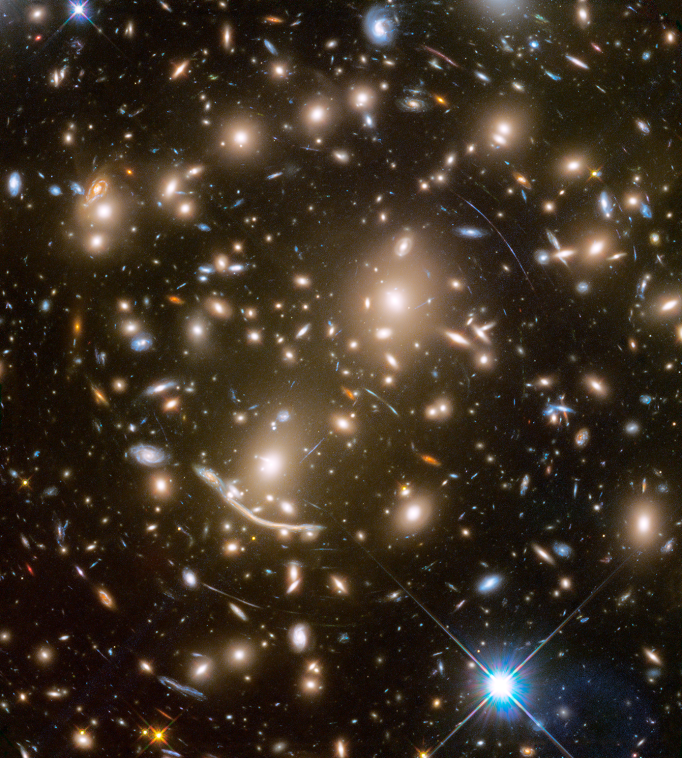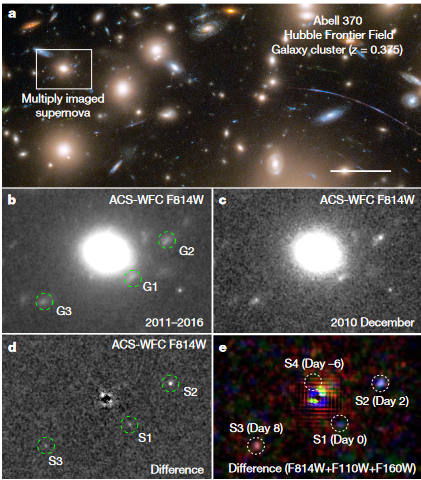A red-supergiant supernova in a galaxy far, far away
When you collect vast amounts of data, most of them will likely be irrelevant or uninteresting. But, hidden in all that noise, you may find a jewel. The data where one scientific jewel, a supernova, has just been found is the collection of observations by the Hubble Frontier Fields (HFF) project.
HFF drew on the power of massive clusters of galaxies to unleash the full potential of the Hubble Space Telescope. A gravitational lens is any object that deflects light by gravitation as described by the general theory of relativity; it is analogous to a lens in optics. The gravity of these clusters warps and magnifies the faint light of the distant galaxies behind them. Hubble captured the boosted light, revealing the farthest galaxies humanity has ever encountered.

The photogenic Abell 370 galaxy cluster contains an astounding assortment of several hundred galaxies tied together by the mutual pull of gravity. Located approximately 4 billion light-years away in the constellation Cetus, the Sea Monster, this immense cluster is a rich mix of a variety of galaxy shapes.
Scientists searched 1 for gravitational lensed, transient events in HFF. And found three images of a rapidly evolving, strongly lensed supernova in imaging of Abell 370 field obtained in December, but 2010. With this three images, they were able to measure the size of a star dating back 2 billion years after the Big Bang, or more than 11 billion years ago.

This measurement was possible because, even though the three images can be seen at the same time, they show the supernova as it was at different ages separated by several days, due to the time delays and magnifying ability of galaxy-scale gravitational lenses. The core-collapse supernova of a massive star rapidly brightens when a shock, produced following the collapse of its core, reaches the stellar surface. As the shock-heated star subsequently expands and cools, its early-time light curve should have a simple dependence on the size of the progenitor and its final evolutionary state. Hence, just one set of images allowed the researchers to see the supernova rapidly cooling. With that information, they were able to reconstruct what happened and study how the supernova cooled in its first few days.
The star in question had a radius about 500 times larger than that of the Sun, which is consistent with a red supergiant, and it’s located at redshift three, which is about 60 times farther away than any other supernova observed in this detail.
More on the subject:
Cloudy, with a chance of supernova
How to analyse data from galaxy spectroscopic surveys without assuming a cosmological model
Author: César Tomé López is a science writer and the editor of Mapping Ignorance
Disclaimer: Parts of this article may have been copied verbatim or almost verbatim from the referenced research papers
References
- Wenlei Chen, Patrick L. Kelly, Masamune Oguri, Thomas J. Broadhurst, Jose M. Diego, Najmeh Emami, Alexei V. Filippenko, Tommaso L. Treu & Adi Zitrin (2022) Shock cooling of a red-supergiant supernova at redshift 3 in lensed images. Nature doi: 10.1038/s41586-022-05252-5 ↩